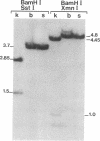Abstract
The murine Ia antigens, encoded by the I region of the major histocompatibility complex, are cell-surface glyco-proteins (consisting of alpha and beta polypeptides) thought to be involved in the control of immune responsiveness. Mice of haplotypes b, s, q, and f fail to express one of the Ia antigen complexes, the E complex, on the cell surface. We have attempted to determine at the molecular level how such a defect (or defects) might be generated. By using I-region E alpha and A alpha gene probes for analyses of RNA and DNA structure, it was possible to conclude that at least three mechanisms can operate. Mice of haplotypes b and s bear a deletion in the E alpha gene, f haplotype mice synthesize predominantly an E alpha mRNA of aberrant size, and mice of the q haplotype seem to have a defect in RNA processing or a problem with mRNA stability, or both.
Full text
PDF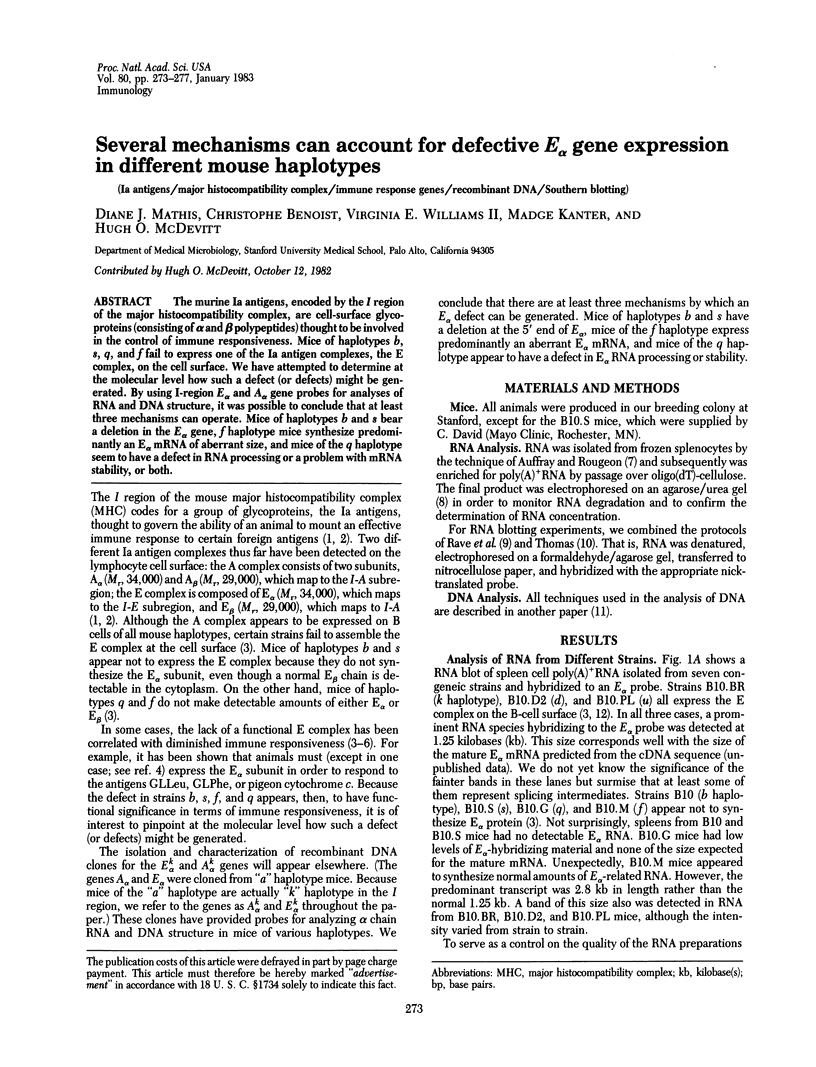
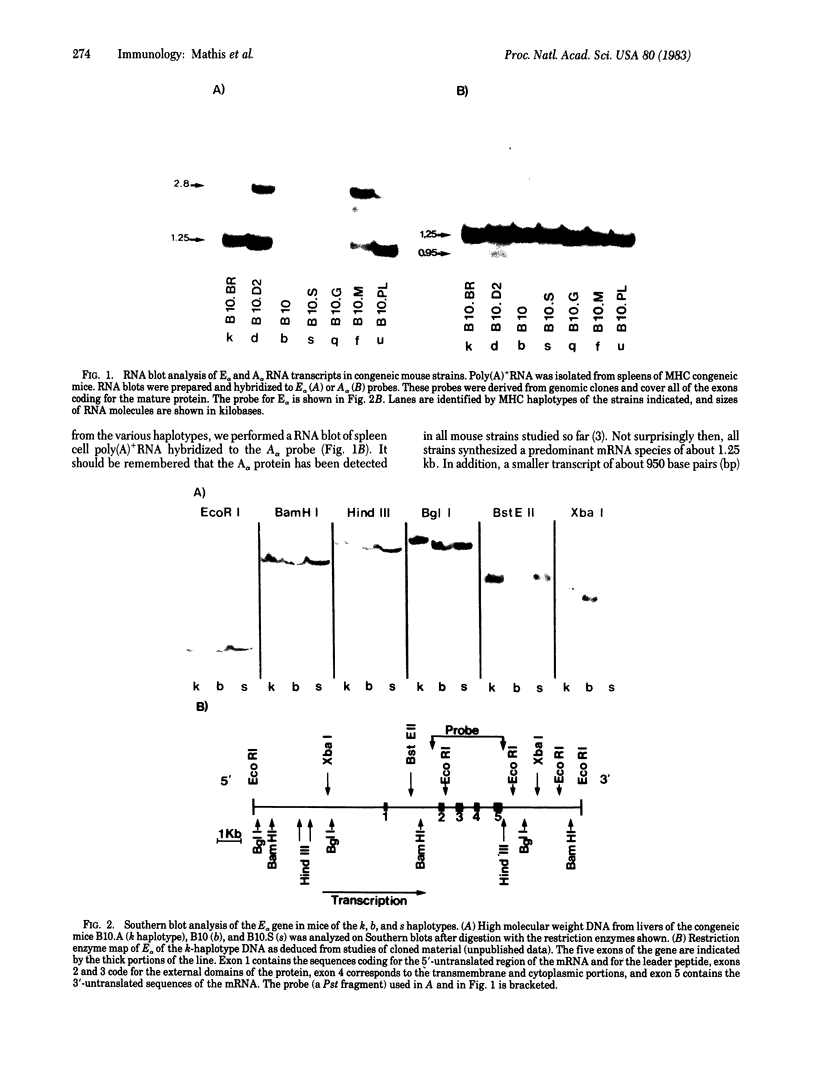
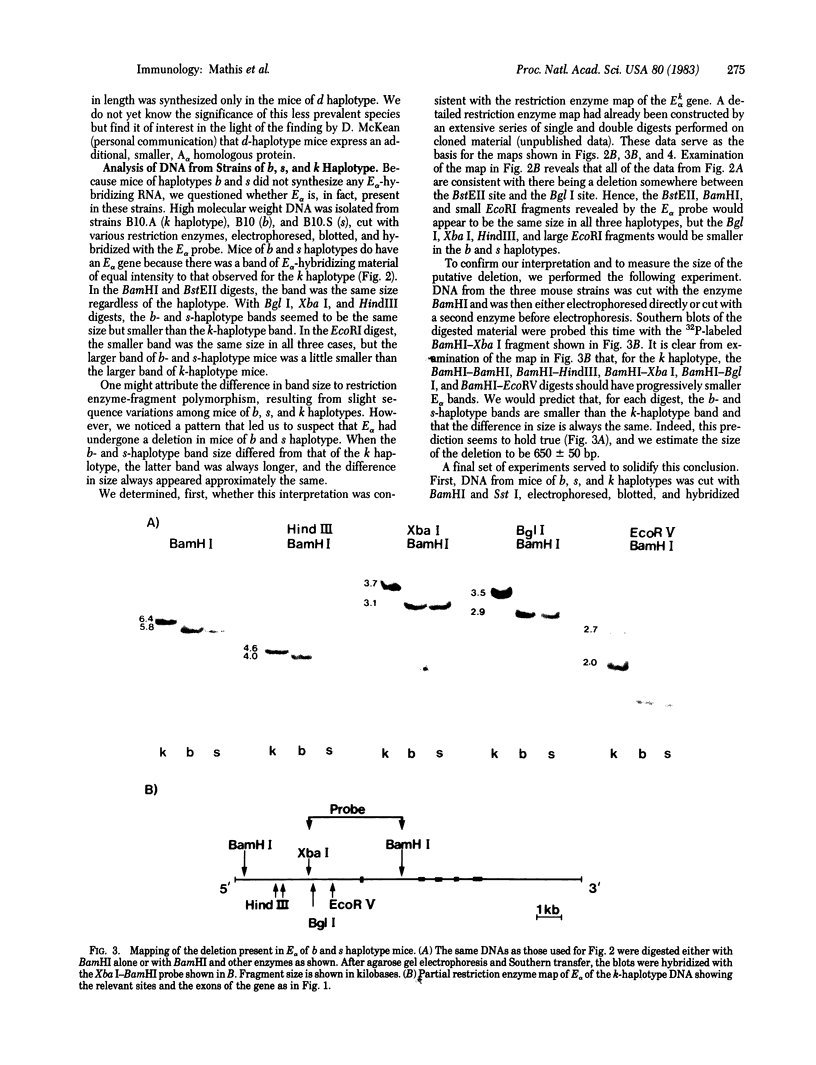
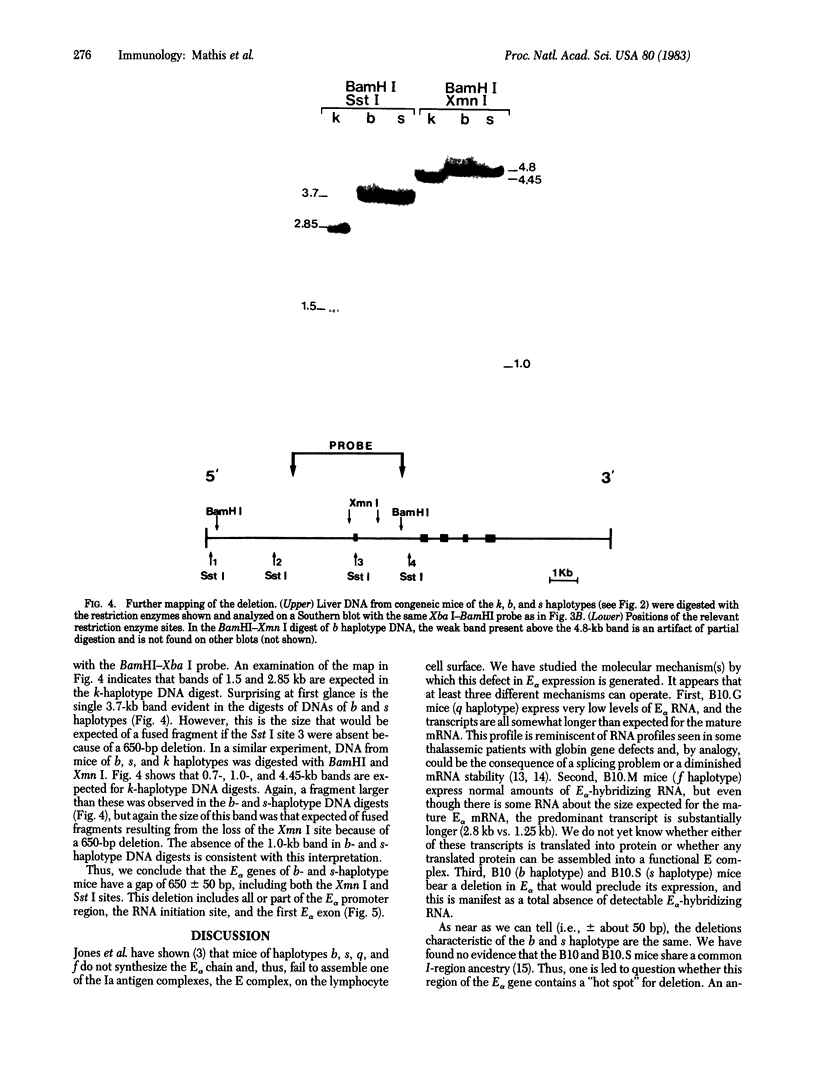

Images in this article
Selected References
These references are in PubMed. This may not be the complete list of references from this article.
- Auffray C., Rougeon F. Purification of mouse immunoglobulin heavy-chain messenger RNAs from total myeloma tumor RNA. Eur J Biochem. 1980 Jun;107(2):303–314. doi: 10.1111/j.1432-1033.1980.tb06030.x. [DOI] [PubMed] [Google Scholar]
- Benacerraf B., Dorf M. E. Genetic control of specific immune responses and immune suppressions by I-region genes. Cold Spring Harb Symp Quant Biol. 1977;41(Pt 2):465–475. doi: 10.1101/sqb.1977.041.01.054. [DOI] [PubMed] [Google Scholar]
- Benoist C. O., Mathis D. J., Kanter M. R., Williams V. E., 2nd, McDevitt H. O. The murine Ia alpha chains, E alpha and A alpha, show a surprising degree of sequence homology. Proc Natl Acad Sci U S A. 1983 Jan;80(2):534–538. doi: 10.1073/pnas.80.2.534. [DOI] [PMC free article] [PubMed] [Google Scholar]
- Götze D., Nadeau J., Wakeland E. K., Berry R. J., Bonhomme F., Egorov I. K., Hjorth J. P., Hoogstraal H., Vives J., Winking H. Histocompatibility-2 system in wild mice. X. Frequencies of H-2 and Ia antigens in wild mice from Europe and Africa. J Immunol. 1980 Jun;124(6):2675–2681. [PubMed] [Google Scholar]
- Jones P. P., Murphy D. B., McDevitt H. O. Variable synthesis and expression of E alpha and Ae (E beta) Ia polypeptide chains in mice of different H-2 haplotypes. Immunogenetics. 1981;12(3-4):321–337. doi: 10.1007/BF01561674. [DOI] [PubMed] [Google Scholar]
- Klein J., Juretic A., Baxevanis C. N., Nagy Z. A. The traditional and a new version of the mouse H-2 complex. Nature. 1981 Jun 11;291(5815):455–460. doi: 10.1038/291455a0. [DOI] [PubMed] [Google Scholar]
- Klein J., Merryman C. F., Maurer P. H., Hauptfeld M., Gardner M. B. Histocompatibility-2 system of wild mice. IV. Ia and Ir typing of two wild mouse populations. Cold Spring Harb Symp Quant Biol. 1977;41(Pt 2):457–463. doi: 10.1101/sqb.1977.041.01.053. [DOI] [PubMed] [Google Scholar]
- Locker J. Analytical and preparative electrophoresis of RNA in agarose-urea. Anal Biochem. 1979 Oct 1;98(2):358–367. doi: 10.1016/0003-2697(79)90154-4. [DOI] [PubMed] [Google Scholar]
- Maquat L. E., Kinniburgh A. J., Rachmilewitz E. A., Ross J. Unstable beta-globin mRNA in mRNA-deficient beta o thalassemia. Cell. 1981 Dec;27(3 Pt 2):543–553. doi: 10.1016/0092-8674(81)90396-2. [DOI] [PubMed] [Google Scholar]
- McDevitt H. O. The role of H-2 I region genes in regulation of the immune response. J Immunogenet. 1981 Aug;8(4):287–295. doi: 10.1111/j.1744-313x.1981.tb00771.x. [DOI] [PubMed] [Google Scholar]
- McNicholas J. M., Murphy D. B., Matis L. A., Schwartz R. H., Lerner E. A., Janeway C. A., Jr, Jones P. P. Immune response gene function correlates with the expression of an Ia antigen. I. Preferential association of certain Ae and E alpha chains results in a quantitative deficiency in expression of an Ae:E alpha complex. J Exp Med. 1982 Feb 1;155(2):490–507. doi: 10.1084/jem.155.2.490. [DOI] [PMC free article] [PubMed] [Google Scholar]
- Orkin S. H., Kazazian H. H., Jr, Antonarakis S. E., Goff S. C., Boehm C. D., Sexton J. P., Waber P. G., Giardina P. J. Linkage of beta-thalassaemia mutations and beta-globin gene polymorphisms with DNA polymorphisms in human beta-globin gene cluster. Nature. 1982 Apr 15;296(5858):627–631. doi: 10.1038/296627a0. [DOI] [PubMed] [Google Scholar]
- Rave N., Crkvenjakov R., Boedtker H. Identification of procollagen mRNAs transferred to diazobenzyloxymethyl paper from formaldehyde agarose gels. Nucleic Acids Res. 1979 Aug 10;6(11):3559–3567. doi: 10.1093/nar/6.11.3559. [DOI] [PMC free article] [PubMed] [Google Scholar]
- Schwartz R. H., David C. S., Sachs D. H., Paul W. E. T lymphocyte-enriched murine peritoneal exudate cells. III. Inhibition of antigen-induced T lymphocyte Proliferation with anti-Ia antisera. J Immunol. 1976 Aug;117(2):531–540. [PubMed] [Google Scholar]
- Solinger A. M., Ultee M. E., Margoliash E., Schwartz R. H. T-lymphocyte response to cytochrome c. I. Demonstration of a T-cell heteroclitic proliferative response and identification of a topographic antigenic determinant on pigeon cytochrome c whose immune recognition requires two complementing major histocompatibility complex-linked immune response genes. J Exp Med. 1979 Oct 1;150(4):830–848. doi: 10.1084/jem.150.4.830. [DOI] [PMC free article] [PubMed] [Google Scholar]
- Thomas P. S. Hybridization of denatured RNA and small DNA fragments transferred to nitrocellulose. Proc Natl Acad Sci U S A. 1980 Sep;77(9):5201–5205. doi: 10.1073/pnas.77.9.5201. [DOI] [PMC free article] [PubMed] [Google Scholar]






